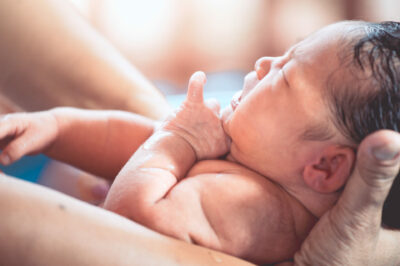As waterbirth has been found to be a safe birth choice, this article covers the most common questions about waterbirth. Birth is a life-changing event that can have long lasting physical and emotional effects on a woman and her baby. It’s important to learn about and then carefully consider the birth choices available to you. Waterbirth is one birth choice that is definitely worth exploring and learning about.
Waterbirth can be defined as giving birth under water in a deep, warm tub or birth pool. Giving birth in the water is an excellent birth choice for women interested in having non-pharmaceutical pain relief and/or a low-intervention vaginal birth.
Birthing in the water also increases levels of satisfaction with childbirth and the overall birthing experience. This higher rate of satisfaction has been linked to women having more autonomy (feeling more in control of their body and the birth process) while in water.
Some refer to waterbirth as “gentle birth” because the baby transitions from the warmth of the womb directly into a warm tub of water to the safety of mom’s chest (skin-to-skin).
Many advocates for natural or physiological birth are also proponents of waterbirth.
History of Waterbirth
We tend to think of waterbirth as trendy but is in no way a new concept. There are accounts of waterbirth dating all the way back to the Egyptians and Ancient Greeks. An oral tradition of waterbirth has existed in many cultures including the Maori and the native people of Central America.
The first written account of Waterbirth appeared in a French Journal in 1805. A woman who had labored for two days, was advised to get into a bath of water, helping her labor to progress so fast that the baby was born safely into the water.
The Russian researcher and male Midwife, Igor Tjarkovsky, considered by some as the pioneer of waterbirth, installed a large glass tank in his home in Moscow in the 1960’s. Though he is a controversial figure, the stunning photographs of births he attended helped to inspire interest in waterbirth in the West.
Michel Odent, a French Obstetrician, is considered a pioneer in the natural birth movement for bringing home-like birthing rooms and birthing pools into maternity hospitals. Early on, he thought the water would help lessen the pain of childbirth but later found that the water also helped labor to progress. Odent wrote the first article about the use of birth pools in medical literature, Birth under Water, published in The Lancet in 1983. One of his more famous quotes is:
To change the world, we must first change the way babies are being born.
Inspired by the news and photographs coming out of Europe, the first waterbirths in the West took place at home in pools, attended by independent Midwives. Parents were creating their own birthing pools from just about any large waterproof vessel they could find – including cattle troughs and garden ponds lined with plastic. This was occurring in various parts of the world simultaneously and caused a great commotion in the obstetric world!
The first documented waterbirth in the US was in 1980 when a woman gave birth to a healthy baby after only 1 1/2 hours of labor.
The first US waterbirth article Water birth: one birthing center’s observations was published in 1989 in the Journal of Nurse-Midwifery. The author, Church, reported no complications in the first 483 women to have a waterbirth at The Family Birthing Center in Upland, California between 1985-1989.
Over the last 20 years, laboring and birthing in the water has continued to grow in popularity around the world and in the US.
What are the Benefits of Waterbirth?
A large Cochrane review (Cluett & Burns 2009) found that laboring in water reduces the use of epidural for pain relief and shortened the 1st stage of labor (the part before the pushing). Why might that be? Laboring or birthing in the water provides:
Decreased Discomfort/Pain
Women who give birth in the water almost universally report a more comfortable experience.
Promotes Relaxation
Water is relaxing for humans (think warm bath). Physical and mental relaxation is well known to speed labor and allow the body to work optimally.
Drug-Free Pain Management for Labor
An increasing number of families hope to avoid pharmaceutical pain medication. Water is often called “the Midwife’s epidural.” While it obviously doesn’t work in the manner an epidural does, people who choose to labor in water are less likely to request drugs for pain management.
Shortens Total Length of Labor
A randomized control trial Comparison of the effects of water and traditional delivery on birthing women and newborns of 160 first-time moms found that women who labor in water have shorter labors by an average of 50 minutes when compared to those giving birth on the land.
Possible Reduced Tearing when Pushing
Some health care providers have found that water supports the perineum during pushing and that for a variety of reasons, their clients in the water tear less and less often. If your bottom is more relaxed, it makes sense!
Lower Episiotomy Rate
If you’re giving birth in a place that does a lot of episiotomies, you’re much less likely to be cut with waterbirth. (It’s impossible to cut you while you’re way down there underwater!) Generally healing is much easier with a natural tear than with an episiotomy.
Allows for Personal Space
One of the reasons a birth tub is so relaxing has nothing to do with the water! When you’re in a big blow-up pool, you have automatic and enforced personal space. People aren’t all up in your business and you have a sense of protection and maybe a little privacy.
If you want your partner in there with you, there’s a little couples cocoon. Personal space and a semblance of privacy are what your mammalian brain dictates for safe birth; hormones work better in these circumstances.
Maintains Mobility
In a big birthing pool, you have a kind of sphere of space to move in. The water is anti-gravity and you feel freer to move however you like in there. If you’re not in the water, you may still have [even more] freedom of mobility, but you may be inclined or encouraged to move to the bed or feel like you can’t get out of a certain position. Mobility aids labor progress and is more comfortable for you when having your baby.
Reduces Stress + Blood Pressure
Stress in the body takes many forms. Hormones, breathing, heartrate, blood pressure, muscle tension, etc. One of the goals of birth attendants is to lower the stress of what is undeniably a stressful event.
Whatever we can do to support the body to do this hard thing makes birth safer and the birth experience more enjoyable. Water, we know, is relaxing, and therefore reduces many indices of stress on the body. In labor, notably, blood pressure.
Creates Endorphins
Endorphins are the good hormones that give you energy and zing and decrease sensations of discomfort. They’re like natural pain relievers. More endorphins are created with water use in labor.
Better Overall Birth Experience
Women report a better overall experience of childbirth when giving birth in the water compared to giving birth on land.
In one study, The effects of delivery in water on duration of delivery and pain compared with normal delivery, 72.3% of women who had a waterbirth reported that they would choose this method of giving birth again, vs only 8.7% of those who gave birth on land saying they would choose that method again.
In another study Women’s experience of waterbirth of 170 mothers who had waterbirths, the birth experience was often described as “quite pleasurable” or “very pleasurable and fulfilling.” 81% of the mothers were in favor of having another waterbirth. And two-thirds said that the best part of water birth was that their babies were not taken away from them right after birth.
Who is a Good Candidate for Waterbirth?
Providers who offer waterbirth will have protocol for who can safely give birth in the water. Generally a good candidate for waterbirth includes the following:
- Low-risk where an uncomplicated delivery is anticipated
- Over 37 weeks gestation
- Baby’s head will be down
- Pregnant with a single baby
There are providers, although rare, who offer breech or twin waterbirth such as Dr. Stu of Birthing Instincts. If you really desire waterbirth, find a provider who will have an open and honest discussion with you about the risks and benefits of your individual situation.
Choosing a Waterbirth Provider
If you want to have a waterbirth, choose a provider that not only offers this birth option but also regularly attends waterbirths. Homebirth and birth center Midwives almost universally support and offer water births.
Most waterbirths are provided by and supported by Midwives, with very few traditional doctors (ObGyns) assisting waterbirths. There are differences in how Midwives practice vs Ob’s and it is important to understand the models of care each provide.
Where Can I Have a Waterbirth?
- At Home. Your Midwife may help you use your own bathroom tub or provide an inflatable birth tub that can be set up in your bedroom or living room. If your Midwife doesn’t have access to a portable waterbirth tub, you can rent or buy one yourself.
- At a Birth Center. Most birth centers offer and support homebirth. You can tour the birth center you are thinking of delivering at and check our their birth tubs.
- Some Hospitals. Some hospitals have birth tubs in their birth rooms. Ask your provider and your hospital if they have birthing tubs in all labor rooms or just some and if they provide inflatable birthing pools. Just because a hospital has birth tubs doesn’t mean your provider will be comfortable with using them.
Choosing Between Hospital, Birthing Center or Home?
The choice between giving birth at a hospital or birthing center or your home comes down to identifying which environment aligns best with your values and offers the most choices you are looking for. It may help you to make a list of the pros and cons of each birth setting.
Keep in mind that often your choice of birth provider will impact what birth location choices and birth options you have. The Birth Profile Assessment helps with providing insights into your unique personality and belief system to help identify the type of provider and place you may be best suit you and your baby.
In making your decision, spend some time thinking about and researching all the options. Writing a birth plan is a great way to identify what you want your experience to be like for you and your baby.
Hydrotherapy (Immersion in Water vs. Waterbirth)
There is a difference between water immersion (being in the birth tub when you are ‘in labor’) and waterbirth. When the baby is born into the water, that’s what is technically meant by waterbirth. Be sure to ask your provider if they are comfortable with waterbirth or only water immersion for labor–before pushing.
People may use the term waterbirth when they’re planning a birth that involves immersion in water. They may end up delivering in the water or getting out and preferring a land birth. In the research, though, waterbirth means that the baby is delivered in the water.
Most of the benefits of water birth are related to hydrotherapy from immersion in water during labor and delivery. If waterbirth is not an option for you, you may still benefit from planning for labor hydrotherapy. You can use your own tub at home before you leave for the hospital, the shower at home or at the birth place, or the tubs provided at the birth center or hospital. You’ll just get out for the pushing phase.
Is Waterbirth Safe?
The ACNM (American College of Nurse-Midwives) and MANA (Midwives Alliance of North America) both support Waterbirth.
The ACNM’s position paper states that:
Women should be given the opportunity to remain immersed during labor and
birth if they wish to do so within the context of a shared decision-making process with
their health care providers. This process includes ongoing maternal and fetal assessment
as labor progresses.
Read the full ACNM position statement
MANA & the Citizens for Midwifery’s joint position paper states:
Water immersion in labor and birth can facilitate normal physiologic birth by offering pain relief, privacy, comfort, warmth and mobility to the mother and is associated with increased maternal satisfaction with the birth experience. The Midwives Alliance of North America (MANA) and Citizens for Midwifery (CfM) support ongoing access to water immersion during labor and birth across all birth settings.
Read the full MANA’s & CfM’s joint position statement
The American College of Obstetrician’s (ACOG) and The American Academy of Pediatrics (AAP) joint position statement supports water immersion in the first stage of labor, however it does not yet support water immersion during second stage or during delivery stating:
Immersion in water during the first stage of labor may be associated with shorter labor and decreased use of spinal and epidural analgesia and may be offered to healthy women with uncomplicated pregnancies between 37 0/7 weeks and 41 6/7 weeks of gestation. There are insufficient data on which to draw conclusions regarding the relative benefits and risks of immersion in water during the second stage of labor and delivery. Therefore, until such data are available, it is the recommendation of the College that birth occur on land, not in water.
Read the full ACOG & AAP joint position statement here
Pregnancy by Design’s Opinion On Waterbirth
Anything that benefits the laboring mother benefits the baby. Mother and baby are basically one body and share all experiences! There are a few baby-specific benefits to waterbirth as well.
The baby has lived his whole life floating in water–amniotic fluid. To be delivered into warm water is a much more gentle transition. The baby can then be lifted out slowly and kept warm on the mothers chest for a while. Skin on skin is an essential part of mother-baby bonding.
Two of the Largest Waterbirth Studies
2021 observational waterbirth study
Oregon State University researchers conducted the largest waterbirth cohort study to date released in 2021 Maternal and neonatal outcomes following waterbirth. The study was a continuation of the 2016 MANA waterbirth study.
The study included 17,530 waterbirths and 17,530 propensity score-matched land births. Propensity scoring means the researchers adjusted simultaneously for more than 80 confounders (variables) such as demographic and pregnancy risk that would affect variables being studied. The study concluded that for those with healthy, low-risk pregnancies, waterbirths are associated with better outcomes overall than non-water births. They also found no difference in outcomes for most measures including neonatal death.
2017 meta-analysis waterbirth study
The 2017 meta-analysis Neonatal outcomes with water birth covers the largest number of waterbirth studies (39 in total – 5 randomized control trials and 34 observational studies) over the longest period of time. The research focused on neonatal outcomes in 28,529 low-risk hospital waterbirths compared to low-risk land births at the hospital.
Researchers found no statistical difference in neonatal outcomes between waterbirth and land birth including Apgar scores (a measure of newborn’s health), NICU admission (intensive care for newborns), or neonatal infection.
Evidence Based Birth did a thorough review of the studies regarding waterbirth and found:
No increase in…any bad health outcomes including NICU admission, low Apgar, breathing difficulty, need for resuscitation, infections, umbilical cord pH, or hypothermia
The Midwives of New Jersey, a premier Midwifery group, wrote an article detailing all of the available research on waterbirth.
Won’t the Baby Try to Breathe Underwater?
No. The baby won’t feel a reflex to breathe until cool air fills his nose and mouth. All babies are also born with mild hypoxia (low oxygen) and prostaglandins that both inhibit the breathing reflex and the use of breathing muscles.
Remember that fetal lungs are filled with fluid until baby stars breathing and/or the cord is cut. The blood stream bypasses the lungs until the heart valves close up and begin diverting blood to the lungs (to get oxygen). Because of the thick fluid and high pressure inside the lungs, nothing can get in. So at the moment of birth, a baby surrounded by fluid will not feel an impulse to breathe at all.
Babies Have a Diving Reflex
Babies have a diving reflex, which automatically closes the glottis at the back of the throat when the face comes in contact with water. This lasts until your baby is about six months old and means that, while underwater, any solution that enters the throat is swallowed, not inhaled.
There is one precaution that is taken during childbirth. You will be reminded to stay low in the water when you are pushing. It’s important that you have your bottom totally under the water to avoid baby being pushed out into the air, have air exposure, and then quickly being submerged in the water.
Is the Waterbirth Tub Water Clean Enough?
First of all, babies born via vaginal birth are always born in a bacteriologically rich environment. You want some of your germs to get on the baby as it’s born because they help colonize and prime the baby’s immune system. So, the germs you bring in with you are almost never a problem. If you have a condition or infection and you’re worried, ask a waterbirth-knowledgeable provider.
The other place germs could come from is the water itself. City water is chlorinated and therefore not likely to support the existence of any harmful germs. The chlorine evaporates after a day or so and bacteria can be introduced from the air or any contact with the water.
This is why the Midwife or staff will never fill the tub in anticipation of the birth and always wait until you are ready to get in. It’s not safe to fill up since it could be hours or days before you use it (even if you’re already in labor—labor can last days!)
Birth centers, home birth midwives and hospitals always clean with strong disinfectant and always use a new liner and new hose for each person to eliminate passing germs.
What Happens if I Poop in the Birth Tub?
You may pass amniotic fluid, blood, stool, or urine while you are in the tub. These things are a normal part of the birth process and are not a concern. Amniotic fluid, urine, and blood are not dangerous to you or the baby. Poop isn’t really, either, but Midwives and their staff keep little fish nets for removing any stool that does get in the water.
What Do I Need to Know about Laboring in Water?
Besides the information above about the benefits and safety of water for labor and birth, here are some tips that may be helpful:
- Stay hydrated. This applies to everyone, everywhere, who is doing something difficult, but especially in labor and especially in the warm water, which is additionally dehydrating.
- Avoid the tub early in labor. Before about 6 cms, or active, heavy labor, the tub can just slow and prolong labor.
- Be open to moving around if labor slows. You can always get back in, but sometimes the relaxation of the tub calms you so much your labor slows. You may be encouraged to start moving around for awhile to get it going again.
- You cannot have pain relief medications such as epidural or opioid analgesics while in the water. This is due to safety concerns; these medications can make it difficult for you to get out of the tub.
- If you want your partner to have the option to get in the tub with you, make sure they bring a swimsuit. Nakedness on the part of the laboring party is expected and accepted! Other naked people are generally frowned on.
- After the placenta is delivered, most doctors and Midwives ask you to get out of the water to keep a better eye on blood loss. Blood loss in the water is very difficult to gauge, so being on land helps them verify your blood loss is in the normal range and help you recover safely.
Home Waterbirth Checklist:
If you are planning to have a home waterbirth you will need to gather some supplies. This isn’t necessary if you are planning a waterbirth at a birth center or hospital.
- A pool or tub that can be filled with water deep enough to cover your belly – some Midwives have birth tubs they will lend to you, otherwise you can buy or rent a tub.
- Liner for pool or tub – if your Midwife is supplying the tub, she may also supply the liner
- Floating thermometer – helps keep track of the water temperature which should be kept between 97-100 degrees Fahrenheit. It should not exceed 101 degrees Fahrenheit.
- New lead-free garden hose – this will be used to fill the tub
- Hose adapter to attach the hose to an indoor faucet
- Chux pads – some Midwives will supply these for you
- A good supply of hot water. If your hot water runs out quickly, have a couple large stock pots on hand so water can be heated up on the stove.
- Towels (6-8) – these can be old towels but they may make it into your birth photos so choose wisely
- Small fish net – for scooping out debris form the water prior to draining
- 2-4 plastic drop cloths or shower curtains – to cover rugs, floors
- Large bowl (for the placenta)
- Garbage bags
- Paper Towels
- Straws that bend
- Electrolyte drinks
- 1 peribottle/squeeze bottle for rinsing perineum after delivery
- Overnight maxi pads or thick pads
Other nice things to have in preparation for your birth include:
- A playlist of songs
- Candles
- Snacks (cut up fruit, veggies, granola bars),
- Honey (a spoonful provides energy during labor)
- Bath robe
- Lip balm (for dry labor lips)
- Snacks for the birth team are always appreciated
- Freezer meals for postpartum recovery period
What Should I Wear during Labor in the Birth Tub?
You should wear whatever is most comfortable to you. Many women will opt to wear a bathing suit top (tankini or bikini) or a sports bra. If you want more coverage, you can wear a tank or tee shirt.
Your bottom half will generally be uncovered, especially as you near birth, so your Midwife can see what is going on with baby.
Choosing Waterbirth
Laboring and delivering your baby in water is a choice many mothers should consider. While you still may have questions and feel nervous about birthing in water, be sure to consider the many benefits of laboring in water and know you can get out when you start pushing and still take advantage of most, if not all, of the advantages of the water.
Want to learn more about the best birth choices for you? One key step in taking an active role in your birth is to continue learning about birth through childbirth education. The more you know about how your body works, the better off you will be bringing your baby into the world.
Disclaimer: Pregnancy by Design’s information is not a substitute for professional medical advice or treatment. Always ask your healthcare provider about any health concerns you may have.
Cited Research
Bovbjerg, M. L., Cheyney, M., & Caughey, A. B. (2021). Maternal and neonatal outcomes following waterbirth: a cohort study of 17 530 waterbirths and 17 530 propensity score-matched land births. BJOG : an international journal of obstetrics and gynaecology, 10.1111/1471-0528.17009.
Bovbjerg, M. L., Cheyney, M., & Everson, C. (2016). Maternal and Newborn Outcomes Following Waterbirth: The Midwives Alliance of North America Statistics Project, 2004 to 2009 Cohort. Journal of midwifery & women’s health, 61(1), 11–20. https://doi.org/10.1111/jmwh.12394
Cassidy, T. (2006). Birth: The surprising history of how we are born. New York: New Grove.
Cluett ER, Burns E. Immersion in water in labour and birth. Cochrane Database of Systematic Reviews 2009, Issue 2. Art. No.: CD000111. DOI: 10.1002/14651858.CD000111.pub3.
Decker, R. (2018) The Evidence on: Waterbirth.
Richmond H. (2003). Women’s experience of waterbirth. The practising midwife, 6(3), 26–31.
Snapp, Carol DNSc, CNM; Stapleton, Susan Rutledge DNP, CNM; Wright, Jennifer MA, CNM; Niemczyk, Nancy A. PhD, CNM; Jolles, Diana PhD, CNM The Experience of Land and Water Birth Within the American Association of Birth Centers Perinatal Data Registry, 2012-2017, The Journal of Perinatal & Neonatal Nursing: January/March 2020 – Volume 34 – Issue 1 – p 16-26 doi: 10.1097/JPN.0000000000000450
Torkamani, S. A., Kangani, F., and Janani, F. (2010). The effects of delivery in water on duration of delivery and pain compared with normal delivery. Pakistani Journal of Medical Science 26(3): 551-555.
Valle, L.J. Waterbirth Around the World, a History of Waterbirth.
Vanderlaan, V., Hall, P. J., and Lewitt, M. (2017b). Neonatal Outcomes with Water Birth: A Systematic Review and Meta-analysis, Midwifery, 59, 27-38.



 What is a Baby-Friendly or Mother-Friendly Hospital?
What is a Baby-Friendly or Mother-Friendly Hospital?






Good information once again! I am looking forward for more updates.